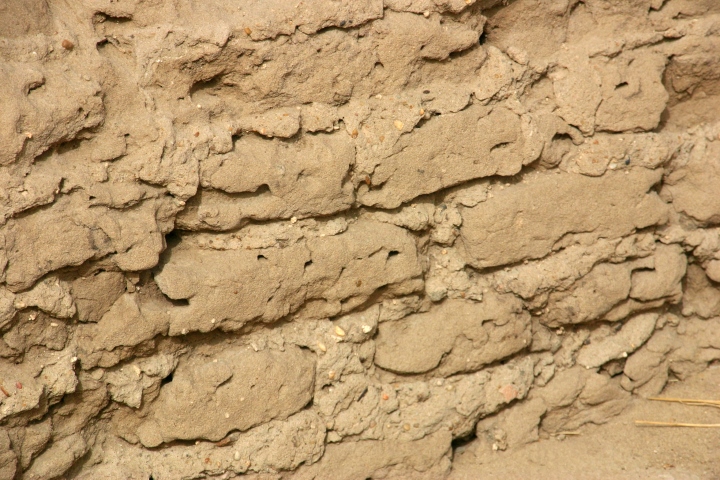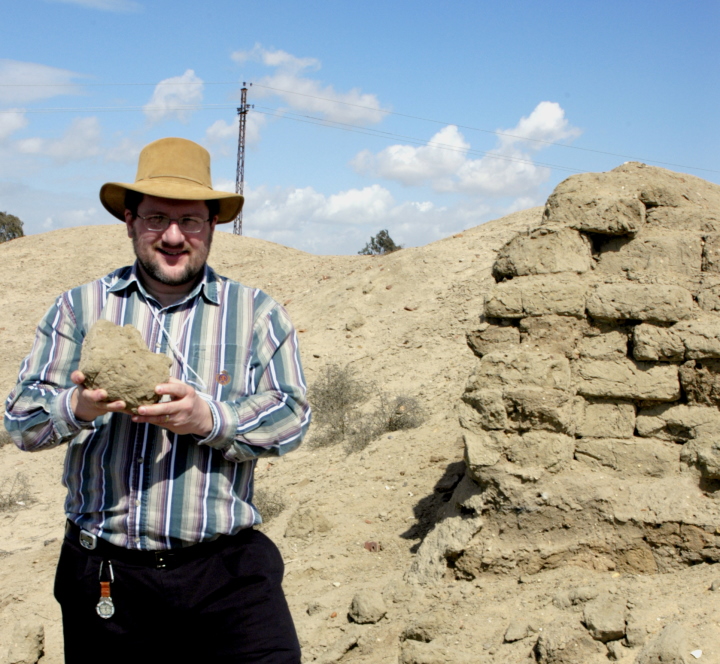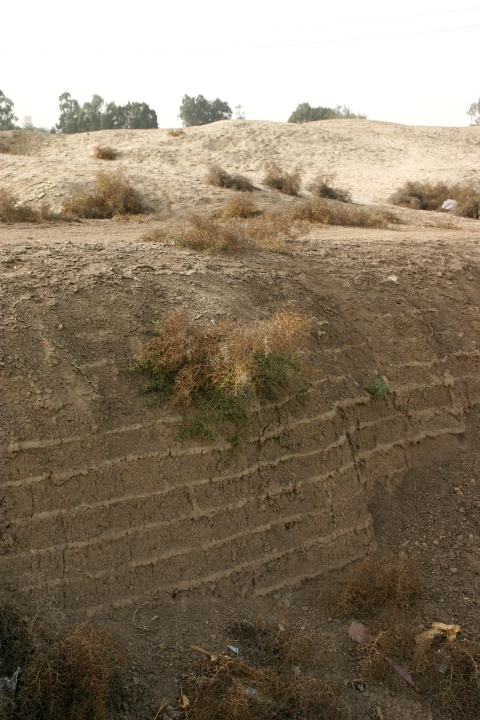|
|
|
|
|
|
|
|
|
|
|
Why
bricks with straw in Egypt at the time of the Exodus?
A few questions arise regarding the use of straw in unbaked mud bricks, as referenced in this Biblical account, including:
Throughout the Bible lands, straw was used in the making of bricks only in Egypt. Other lands, such as the Mesopotamia region, baked their bricks. This was common even in a far earlier period, as shown in Scriptures and verified by archaeology...
In the land of Canaan, bricks were occasionally used, but stone was the normal and widespread building material of choice. Even when bricks were employed they did not utilize straw in them. (See Tell Dan for an example, the bronze age gate was of sun-baked brick, all later were stone). This brings us back to Egypt where we find that bricks with straw were a common building material at this time. Archaeological excavations in the Delta region, especially those dating to around the time of the Exodus, and specifically in regards to the store city of Pithom and nearby Succoth, show that mud brick with straw was the only standard building material. Bricks formerly having straw within them are very distinctive due to the small holes left with the decay of the organic material. |

Remains
of mud bricks at Tell el Retabeh (Pithom) -- dating to the time of
the Exodus
Notice
holes from where the straw has decayed.

The author holding an ancient mud brick made with straw, at Succoth (Tell el-Maskhuta), dating to the time of the Exodus
|
For the bible skeptics who claim that the account of the exodus was a later innovation, perhaps written as late as immediately following the Babylonian exile, small but significant details, such as these mud bricks, point to an author directly familiar with the circumstances and practices of Egypt in the appropriate timeframe. If written in Babylon (Mesopotamia) or even in Canaan, they likely would have reflected local practice in making up such a story. But our Bible account is written by a divinely inspired eyewitness from Egypt. Baked bricks are very strong, but they require a large amount of burnable fuel to bake them. The cost of acquiring this in Egypt may have led to the alternate practice of unfired clay bricks with straw. Certainly the Egyptians were aware of the beneficial effects of baking clay. Evidence from the ruins of burned building would have exhibited this to them. Still, no evidence has been found that burnt bricks were intentionally prepared for use in buildings during the Pre-dynastic Period or the Old Kingdom. A solitary example of burnt brick paving slabs comes from the Middle Kingdom. Yet these were not bricks, measuring almost 1ft x 1 ft x 2 inches (30 x 30 x 5 cm), nor were they used as walls - plus this lonesome example comes from the area of Nubia not lower Egypt. The next isolated example comes from Thebes, in Upper Egypt, during the New Kingdom Period. These fired bricks were used in conjunction with funerary cones in the tombs. It is only late in the New Kingdom Period that a couple examples appear, at Nebesheh and Defenneh, dated to the time of Ramesses II 2. This use of fired bricks, as a constructional material, is certainly an exception and not the rule. It was not until the Roman period that usage of baked bricks became more common place in Egypt, reflecting standard Roman usage elsewhere. Simply put, during the time of the Exodus, large scale baked brick construction was nonexistent in Lower Egypt (the Delta & Goshen region).1 Unlike the Bible, which legitimately notes the widespread usage of mud-bricks with straw, in the region of the Delta at the time of the Exodus, the Qur'an (Koran) makes an interesting claim. Showing that it was written by someone influenced by the culture and practice outside of Egypt, at a much later date, it portrays a boastful and mocking Pharaoh asking his associate Haman to build a lofty tower or palace. (Ignore the fact that the name Haman also is not Egyptian and appears to have been randomly pulled from another biblical account and timeframe). From two different English language translations:
It is safe to say that it would be exceedingly rare for a Pharaoh at the time of the Exodus to ask for a major construction to be built in the Delta out of kiln fired bricks - something that there is absolutely no example of until the time of Ramses II almost a century and a half later. As to the significance of this entire issue: once again archaeology confirms the Bible and, at best, casts serious doubt on the historicity of the account in the Qur'an. Returning to the Biblically cited practice of adding straw to bricks in Egypt, this was done with intent. With the extreme cost of firing bricks in a land without an abundant fuel source, the Egyptians had discovered something not widely known. Bricks made out of mud and straw are three times stronger than those made merely out of dried mud/clay.6 The scientific reason for this is that the straw releases humic acid3, into the mud, assisting in hardening the bricks.4 In a land where this straw-brick practice was unknown, it would be highly unlikely that it would be even suggested. If the Bible account was written in another land by someone who was not a witness to the practice - as skeptics commonly profess - they would have drawn upon local practices which would not have included this very localized yet beneficial method.
More could be said about brick making, as referenced in the Biblical account, but one final comment will have to suffice. Early Egyptian records show that it was common practice for tallies of bricks made by slaves to be recorded.5 The Bible is full of historically accurate details!
End Notes 1) Showing how insignificant and rare any ancient usage of baked bricks was in early Egypt, one reference work makes this contrasting summary:
Another general citation:
2) The archaeologist, who found the only significant exception where kiln-baked bricks were used at Tell Defenneh (alt. Daphnae) at Tahpanhes (alt. Tahpanheth) and the neighboring village of Tell Nebesheh, was Flinders Petrie. These structures were significant not because of size or important use but solely because they were the only exception ever found. The building material of ancient Egypt had always been stone and mud bricks, and remained so until more than a thousand years later, except for these few structures at the time of Ramses II. Dating is considered to be without question because of the cartouche and artifacts associated with the site.
The nearby site at Tell Defenneh likewise yielded the foundation of a single structure comprised of fired bricks, also dating to the time of Ramses II.
3) "Humic acid defies precise description except in very general terms. Black or very dark brown high molecular weight organic polymer is as good a description as any. The color of the materials is effectively used as a sales or advertising attribute. Black organic matter conjures up the image of dark fertile soils covered with lush plant growth. Chemically, humic acid contains more carbon and less hydrogen than does the animal and plant residues from which it has formed through extensive biological decomposition." (Humate and Humic Acid, By Dr. Wayne R. Kussow, Department of Soil Science, University of Wisconsin, Madison. June 2002 web issue of Horticulture Update, edited by Dr. Douglas F. Welsh, and produced by Extension Horticulture, Texas Cooperative Extension, The Texas A&M University System, College Station, Texas.) 4) Gerald Vardaman describes this in Archaeology and the Living Word, 1966, p. 37, and Baruch Halpern writes about Mesopotamian and Canaanite building materials in "The Exodus from Egypt: Myth or Reality?" The Rise of Ancient Israel, Biblical Archaeology Society, Washington D.C., pp 99-100. 5) This practice of recording tallies of bricks may have actually begun during the enslavement of Israel. It was certainly still being practiced a century and a half later. One Egyptian scroll (Louvre Leather Roll 1274) reports that tallies of bricks made by slaves were in fact recorded at this time. The scroll is critical of "Paherypedjet son of Paser," one of the 40 overseers of Rameses II, who failed to deliver his quota of 2,000 bricks. It goes on to say that the shortfall was because the slaves "could not gather the required amount of straw."* As a result, the slaves were beaten. Sounds familiar to the Biblical account doesn't it?! (* K. A. Kitchen, Ramesside Inscriptions [Oxford: Blackwell, 1996] Vol. 2, 520-522 & Out of Egypt," BAR Jan/Feb 2007.) 6) One publication expressly examining Egyptian building materials had this in its subsection on "Mud":
|

More remains of large amounts of mud bricks with straw at Tell el-Maskhuta (Succoth)
All
BibleIsTrue.com articles may be reprinted for non-profit purposes as long
as
the source is cited: www.BibleIsTrue.com (Lion Tracks Ministries)